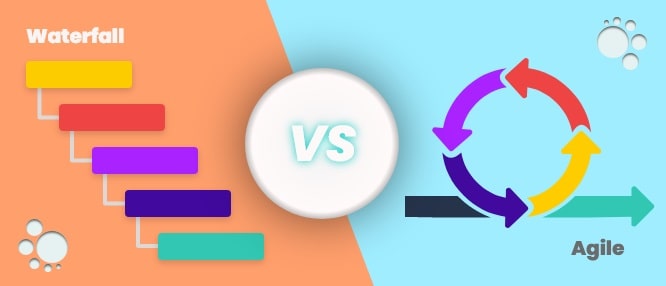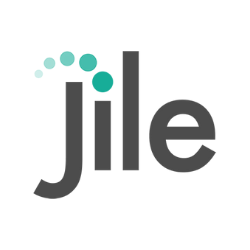Agile vs. Waterfall - Which is right for you?

Agile vs Waterfall as the name tells both methodologies are two different ways of developing software. The Agile methodology is characterized by iterative and incremental development, while the Waterfall methodology is characterized by sequential development. Both have their advantages and disadvantages, so we'll go into detail about the perspective of Waterfall vs Agile to help you choose which will work best for your project, the benefits of agile over waterfall, when is waterfall better than agile, and more.
What is Agile methodology?
The Agile methodology is an iterative and incremental development methodology. This means that it involves a series of short, time-boxed iterations referred to as 'sprints'. At the beginning of each sprint, the team sets specific goals regarding what they want to achieve during that period. They then work towards those goals throughout the sprint, refining, and testing as they go. Once the sprint is over, they evaluate what was accomplished and set new goals for the next sprint.
This approach allows teams to adapt quickly to changes in requirements and consider feedback from stakeholders. It also encourages collaboration between team members and transparency of progress throughout the project.
When comparing Agile vs Waterfall Methodology, the Agile methodology is particularly well-suited to new projects, where requirements are likely to evolve as you go along. It's also great for smaller teams who work more collaboratively and need flexibility in their schedule.
What is Waterfall methodology?
The Waterfall methodology of development is a sequential method that moves from one phase to another without overlap or iteration between phases until reaching acceptance testing at the end of each phase. This means that after approval occurs at one stage, no additional changes can be made before moving onto the next step unless it's a 'critical' change.
The main advantage of Waterfall methodology vs. Agile development is that it provides a clear and concise plan for stakeholders, as they can see all the steps involved in the project and when each will be completed. It also allows for more rigorous testing since features aren't moved on to the next phase until they've been tested and approved.
However, this methodology can often lead to delays due to changes requested during later stages of development. And because there's no room for adaptation or feedback along the way, it can be less effective than Agile for projects with evolving requirements. Additionally, Waterfall requires more up-front planning compared to Agile, which makes it less suitable for projects with unstable requirements.
Advantages of Waterfall Model:
- Provides a clear and concise plan for stakeholders: As we mentioned, one of the main advantages of the Waterfall methodology is that it provides a clear plan for all stakeholders involved in the project. This can be helpful for projects with a lot of moving parts or where there's a lot of uncertainty about what needs to be done.
- Allows for more rigorous testing: Another advantage of Waterfall development is that it allows for more rigorous testing since features aren't moved on to the next phase until they've been tested and approved. This can help ensure that problems are caught and fixed early in the process before they cause delays further down the line.
- Suitable for projects with stable requirements: Because Waterfall requires more up-front planning, it's often a better choice for projects with stable requirements. This is because you have time to plan out all the steps involved and make sure everything is accounted for.
- Requires less up-front planning: Waterfall model allows for less up-front planning compared with Agile. This is because Agile doesn't allow you to move on until requirements are fully tested and validated.
Advantages of the Agile Model:
- Flexible schedule: An advantage of using an agile method when developing a project is that you have more flexibility when it comes to scheduling since each team member's tasks can be rearranged as needed without causing problems further down the line.
- Encourages collaboration: Agile encourages teams to work more collaboratively, which can be an advantage if you have a small team or are working with clients who need frequent updates on your progress.
- High adaptability: Since it involves frequent delivery of incremental features, there's less risk involved compared to waterfall development which focuses on completing all project features before delivering them to customers at the end of the process.
- Less room for delays due to changes requested during later stages: In addition, agile allows for making adjustments throughout every step of the process, so there's less room for delays due to changes requested during later stages of development. Ease your process with agile project management software for developers.
Limitations of Waterfall Model:
- Less suitable for projects with varying requirements: The waterfall model is less effective than Agile when it comes to handling evolving or unpredictable project requirements since you must complete all the steps in a phase before moving on, rather than continuing to deliver features as they become available.
- Lack of room for adaptation and feedback along the way: Another limitation that can be an issue with waterfall development is that there's no room for adaptation or gathering customer feedback during each stage. This means you're often unable to take advantage of any changes requested by your clients later down the line, which could result in delays if not addressed immediately.
- Requires more up-front planning compared to Agile: Finally, one drawback associated with using Waterfall over Agile methods is that it involves more upfront planning which can lead to more costs and delays if your requirements are not flexible enough.
Limitations of Agile Model:
- Requires team commitment and buy-in: One potential downside of using Agile is that it requires more team commitment and buy-in as tasks are often assigned to specific members of the team. If someone drops out or is unable to complete their task, it can cause delays and problems for the rest of the project.
- Can be difficult to use with large teams: Another limitation of Agile development is that it can be difficult to manage when used with large teams. This is because there's a higher risk for communication breakdowns if everyone isn't kept in the loop about what's happening.
Difference between Agile and Waterfall Model
The waterfall model is a sequential software development methodology, while Agile is an iterative and incremental software development framework.
The main difference between the two models is that Waterfall follows a phased approach where requirements are fully defined before work begins. At the same time, Agile focuses on delivering features in short cycles or iterations.
In general, Agile is better suited for projects with unstable requirements, while Waterfall may be more suitable for projects with stable requirements. However, it's important to note that there isn't always a clear-cut answer, and the best method to use will vary depending on the specific project.
Finally, it's also worth mentioning that there are many different flavors of both Agile and Waterfall, so you should carefully examine each option before deciding which is right for you.
Leading Agile Project Management Software Platforms
If you're looking for a software platform that can help you manage your Agile projects, Jile is your go-to solution!
With Jile, you can effectively track the software development progress, manage tasks, and communicate with team members. Choosing the right platform can make a big difference in the success of your project, so it's important to do your research and find one that meets your specific needs.
Summary
So that's all you need to know about the main difference between Agile and Waterfall project management. It is important to note that this post does not serve as professional advice, and we recommend that you consult a project management expert before making any decisions. Request a Jile free demo now!
Thanks for subscribing to our latest blogs, thought leadership and other product updates!
Read our Privacy Notice to know more. You can opt-out of all communications anytime.
